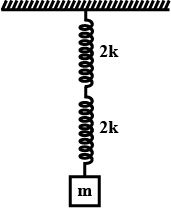
The time period of oscillation of the block as shown in figure is:

(A) $2 \pi \sqrt{\dfrac{m}{2 k}}$
(B) $\pi \sqrt{\dfrac{m}{k}}$
(C) $4 \pi \sqrt{\dfrac{m}{k}}$
(D) $2 \pi \sqrt{\dfrac{m}{k}}$
Answer
219k+ views
Hint: We should know that the time required by a body exhibiting periodic motion to complete one period is known as the time period. The S.I. unit is second. The number of times a body exhibits unique motion (each period) in one second is known as frequency. Oscillation refers to any periodic motion moving at a distance about the equilibrium position and repeating itself over and over for a period of time. Example the oscillation up and down of a spring, the oscillation side by side of a spring. The oscillation swinging side by side of a pendulum.
Complete step by step answer
As seen from the diagram the two springs are in series to each other. So, in this situation the force on each string is the same but the displacement on each string is different.
Thus, we can write that:
$x=x_{1}+x_{2} \quad F_{1}=-k_{1} x_{1}$
Hence the time period is given as:
$\Rightarrow T=2 \pi \sqrt{\dfrac{L}{g_{e f f}}}=2 \pi \sqrt{\dfrac{L}{g+a}} F_{2}=-k_{2} x_{2}$
Thus, we can write that:
$\dfrac{1}{k_{s}}=\dfrac{1}{k_{1}}+\dfrac{1}{k_{2}} \dfrac{F}{k_{1}}=x_{1}$
$\Rightarrow k_{s}=\dfrac{k_{1} k_{2}}{k_{1}+k_{2}} \dfrac{F}{k_{2}}=x_{2}$
Hence the formula of the time period is given as:
$T=2\pi \sqrt{\dfrac{m(2k+2k)}{2k\times 2k}}=2\pi \sqrt{\dfrac{m}{k}}$
So, we can say that the time period of oscillation is given as $2 \pi \sqrt{\dfrac{m}{k}}$.
Hence the correct answer is option D.
Note We can conclude that for something to oscillate, energy needs to move back and forth between two forms. For example, in a pendulum, energy moves between potential energy and kinetic energy. This movement of energy between the two forms is what causes the oscillation. There are many types of electronic oscillators, but they all operate according to the same basic principle: an oscillator always employs a sensitive amplifier whose output is fed back to the input in phase. Thus, the signal regenerates and sustains itself. This is known as positive feedback. A normal mode of an oscillating system is a pattern of motion in which all parts of the system move sinusoidally with the same frequency and with a fixed phase relation. These fixed frequencies of the normal modes of a system are known as its natural frequencies or resonant frequencies.
Complete step by step answer
As seen from the diagram the two springs are in series to each other. So, in this situation the force on each string is the same but the displacement on each string is different.
Thus, we can write that:
$x=x_{1}+x_{2} \quad F_{1}=-k_{1} x_{1}$
Hence the time period is given as:
$\Rightarrow T=2 \pi \sqrt{\dfrac{L}{g_{e f f}}}=2 \pi \sqrt{\dfrac{L}{g+a}} F_{2}=-k_{2} x_{2}$
Thus, we can write that:
$\dfrac{1}{k_{s}}=\dfrac{1}{k_{1}}+\dfrac{1}{k_{2}} \dfrac{F}{k_{1}}=x_{1}$
$\Rightarrow k_{s}=\dfrac{k_{1} k_{2}}{k_{1}+k_{2}} \dfrac{F}{k_{2}}=x_{2}$
Hence the formula of the time period is given as:
$T=2\pi \sqrt{\dfrac{m(2k+2k)}{2k\times 2k}}=2\pi \sqrt{\dfrac{m}{k}}$
So, we can say that the time period of oscillation is given as $2 \pi \sqrt{\dfrac{m}{k}}$.
Hence the correct answer is option D.
Note We can conclude that for something to oscillate, energy needs to move back and forth between two forms. For example, in a pendulum, energy moves between potential energy and kinetic energy. This movement of energy between the two forms is what causes the oscillation. There are many types of electronic oscillators, but they all operate according to the same basic principle: an oscillator always employs a sensitive amplifier whose output is fed back to the input in phase. Thus, the signal regenerates and sustains itself. This is known as positive feedback. A normal mode of an oscillating system is a pattern of motion in which all parts of the system move sinusoidally with the same frequency and with a fixed phase relation. These fixed frequencies of the normal modes of a system are known as its natural frequencies or resonant frequencies.
Recently Updated Pages
Two discs which are rotating about their respective class 11 physics JEE_Main

A ladder rests against a frictionless vertical wall class 11 physics JEE_Main

Two simple pendulums of lengths 1 m and 16 m respectively class 11 physics JEE_Main

The slopes of isothermal and adiabatic curves are related class 11 physics JEE_Main

A trolly falling freely on an inclined plane as shown class 11 physics JEE_Main

The masses M1 and M2M2 M1 are released from rest Using class 11 physics JEE_Main

Trending doubts
JEE Main 2026: Application Form Open, Exam Dates, Syllabus, Eligibility & Question Papers

Derivation of Equation of Trajectory Explained for Students

Hybridisation in Chemistry – Concept, Types & Applications

Understanding the Angle of Deviation in a Prism

Understanding Collisions: Types and Examples for Students

Understanding Atomic Structure for Beginners

Other Pages
JEE Advanced Marks vs Ranks 2025: Understanding Category-wise Qualifying Marks and Previous Year Cut-offs

Units And Measurements Class 11 Physics Chapter 1 CBSE Notes - 2025-26

NCERT Solutions For Class 11 Physics Chapter 8 Mechanical Properties Of Solids

Motion in a Straight Line Class 11 Physics Chapter 2 CBSE Notes - 2025-26

NCERT Solutions for Class 11 Physics Chapter 7 Gravitation 2025-26

How to Convert a Galvanometer into an Ammeter or Voltmeter




